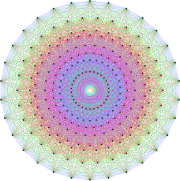| Lie group | Description | Cpt |  |  | UC | Remarks | Lie algebra | dim/R |
|---|
| Rn | Euclidean space with addition | N | 0 | 0 | | abelian | Rn | n |
| R× | nonzero real numbers with multiplication | N | Z2 | – | | abelian | R | 1 |
| R+ | positive real numbers with multiplication | N | 0 | 0 | | abelian | R | 1 |
| S1 = U(1) | the circle group: complex numbers of absolute value 1 with multiplication; | Y | 0 | Z | R | abelian, isomorphic to SO(2), Spin(2), and R/Z | R | 1 |
| Aff(1) | invertible affine transformations from R to R. | N | Z2 | – | | solvable, semidirect product of R+ and R× |  | 2 |
| H× | non-zero quaternions with multiplication | N | 0 | 0 | | | H | 4 |
| S3 = Sp(1) | quaternions of absolute value 1 with multiplication; topologically a 3-sphere | Y | 0 | 0 | | isomorphic to SU(2) and to Spin(3); double cover of SO(3) | Im(H) | 3 |
| GL(n,R) | general linear group: invertible n×n real matrices | N | Z2 | – | | | M(n,R) | n2 |
| GL+(n,R) | n×n real matrices with positive determinant | N | 0 | Z n=2
Z2 n>2 | | GL+(1,R) is isomorphic to R+ and is simply connected | M(n,R) | n2 |
| SL(n,R) | special linear group: real matrices with determinant 1 | N | 0 | Z n=2
Z2 n>2 | | SL(1,R) is a single point and therefore compact and simply connected | sl(n,R) | n2−1 |
| SL(2,R) | Orientation-preserving isometries of the Poincaré half-plane, isomorphic to SU(1,1), isomorphic to Sp(2,R). | N | 0 | Z | | The universal cover has no finite-dimensional faithful representations. | sl(2,R) | 3 |
| O(n) | orthogonal group: real orthogonal matrices | Y | Z2 | – | | The symmetry group of the sphere (n=3) or hypersphere. | so(n) | n(n−1)/2 |
| SO(n) | special orthogonal group: real orthogonal matrices with determinant 1 | Y | 0 | Z n=2
Z2 n>2 | Spin(n)
n>2 | SO(1) is a single point and SO(2) is isomorphic to the circle group, SO(3) is the rotation group of the sphere. | so(n) | n(n−1)/2 |
| SE(n) | special euclidean group: group of rigid body motions in n-dimensional space. | N | 0 | | | | se(n) | n + n(n−1)/2 |
| Spin(n) | spin group: double cover of SO(n) | Y | 0 n>1 | 0 n>2 | | Spin(1) is isomorphic to Z2 and not connected; Spin(2) is isomorphic to the circle group and not simply connected | so(n) | n(n−1)/2 |
| Sp(2n,R) | symplectic group: real symplectic matrices | N | 0 | Z | | | sp(2n,R) | n(2n+1) |
| Sp(n) | compact symplectic group: quaternionic n×n unitary matrices | Y | 0 | 0 | | | sp(n) | n(2n+1) |
| Mp(2n,R) | metaplectic group: double cover of real symplectic group Sp(2n,R) | Y | 0 | Z | | Mp(2,R) is a Lie group that is not algebraic | sp(2n,R) | n(2n+1) |
| U(n) | unitary group: complex n×n unitary matrices | Y | 0 | Z | R×SU(n) | For n=1: isomorphic to S1. Note: this is not a complex Lie group/algebra | u(n) | n2 |
| SU(n) | special unitary group: complex n×n unitary matrices with determinant 1 | Y | 0 | 0 | | Note: this is not a complex Lie group/algebra | su(n) | n2−1 |
|




